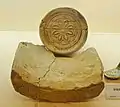Mikawa Kokubun-ji
The Mikawa Kokubun-ji (三河国分寺) is a Buddhist temple located in what is now the city of Toyokawa, Aichi, Japan. It is the modern successor of one of the provincial temples established by Emperor Shōmu during the Nara period (710 – 794) for the purpose of promoting Buddhism as the national religion of Japan and standardising control of Yamato rule over the provinces.[1]
| Mikawa Kokubun-ji | |
|---|---|
三河国分寺 | |
_2.jpg.webp) Former Main Hall of Mikawa Kokubun-ji | |
| Religion | |
| Affiliation | Buddhist |
| Deity | Yakushi Nyorai |
| Rite | Sōtō |
| Status | functional |
| Location | |
| Location | Hachiman-chō Hongo 31, Toyokawa-shi, Aichi-ken |
| Country | |
 Shown within Aichi Prefecture  Mikawa Kokubun-ji (Japan) | |
| Geographic coordinates | 34°50′17.45″N 137°20′32.43″E |
| Architecture | |
| Founder | Emperor Shomu |
| Completed | 741 |
The site of the original temple was designated as a National Historic Site by the Japanese government in 1922.[2]
History
The exact date that the Mikawa Kokubun-ji was founded is not known. It was long assumed that the temple was constructed in 741 as the provincial temple of Mikawa Province; however, recent excavations indicate that the pagoda was erected before the other structures in the temple. This implies that a temple already existed on this site, but was remodeled accordance with the standardized Shichidō garan formation, similar to Todai-ji in Nara, upon which the kokubunji temples were based, at some later date. The temple's bell is estimated to date to the early Heian period.
The layout of the original temple was 180 meters square. Archaeological investigations discovered the foundations of the South Gate, Central Gate, Kon-dō and Lecture Hall, as wells as the foundations of the surrounding cloister. The 16.8 meters square foundation stones for the pagoda have been exposed since antiquity. No roof tiles have been found at the site, indicating that the original temple had hinoki shingles instead of tiles.
Per the Engishiki records, the temple was allowed a revenue of 20,000 koku of rice land for its upkeep in 927 AD. Subsequent changes to the temple are unclear, and the temple appears to have been abandoned around the end of the 10th century.
The Mikawa Kokubun-ji was restored during the Eishō era (1504-1521) of the Sengoku period under the sponsorship of the Imagawa clan, and the temple was renamed the Hachiman Kokubun-ji, indicating a connection with a nearby Hachiman shrine. The reconstructed temple belongs to the Sōtō sect of Japanese Zen. In 1649, under the Tokugawa shogunate, the temple had an assigned kokudaka of over five koku for its upkeep.
The grounds of the temple were excavated from 1985-1988 and from 2007-2009. It is located about 20 minutes on foot from Kokufu Station on the Meitetsu Nagoya Main Line.
Cultural Properties
Bell
The bronze bell at the Mikawa Kokubun-ji dates from the early Heian period and was designated an Important Cultural Property of Japan in 1922.[3] The bell is unsigned, and has a height of 118 cm, circumference of 256 cm, opening of 82.4 cm and a wight of 687 kilograms.
 Kondo
Kondo Site of Lecture Hall
Site of Lecture Hall Site of Eastern Cloister
Site of Eastern Cloister Site of Nandai-mon
Site of Nandai-mon 国分寺跡出土品
国分寺跡出土品 Bell
Bell 創建期瓦
創建期瓦
References
- "Kokubunji". Encyclopedia of Japan. Tokyo: Shogakukan. 2012. Archived from the original on 2007-08-25. Retrieved 2012-05-04.
- "三河国分寺跡" (in Japanese). Agency for Cultural Affairs.
- "豊川市の指定文化財" (in Japanese). Toyokawa City.
External links
| Wikimedia Commons has media related to Mikawa Kokubunji. |
- Toyokawa City home page(in Japanese)